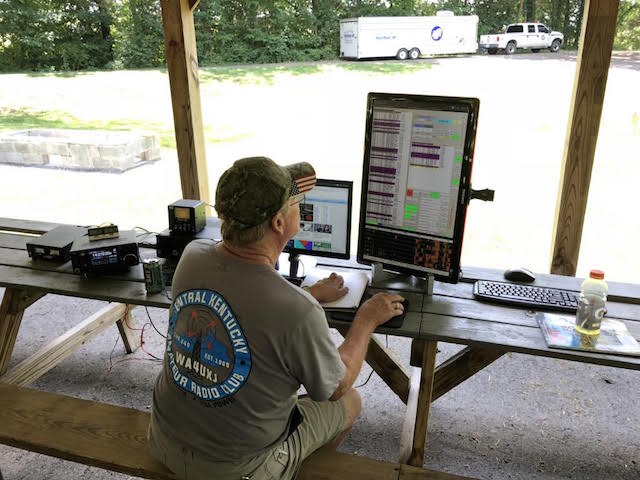| ||||||||||
Dr. Ronald P. Rogers CHIROPRACTOR Support for your body's natural healing capabilities 270-384-5554 Click here for details 


Columbia Gas Dept. GAS LEAK or GAS SMELL Contact Numbers 24 hrs/ 365 days 270-384-2006 or 9-1-1 Call before you dig Visit ColumbiaMagazine's Directory of Churches Addresses, times, phone numbers and more for churches in Adair County Find Great Stuff in ColumbiaMagazine's Classified Ads Antiques, Help Wanted, Autos, Real Estate, Legal Notices, More... 

|
HAM Radio: Amateur Radio used daily locally Part I of HAM Radio in our area appeared earlier at this link. This is part two of three parts to update readers on this important part of local emergency communications. By Mike Keltner, Director, Adair Co. Emergency Management As the Adair County Emergency Management Director, I am fortunate to be involved with and be a part of the Central Kentucky Amateur Radio Club (CKARC). An interest in amateur radio was sparked when I became Director in 2015. As I was reading the County Emergency Operations Plan I noticed amateur radio or HAM radio being mentioned over 30 times in the 300 plus page document. If it was this important I felt I should gain knowledge. Deputy EM Director Tracy McCarol and EM Operations Support Person Jimmie Dale Cox began their positions and we discussed amateur radio as they were already licensed and active. The decision was made that I must be licensed also. Since then I have advanced my license to the highest available Extra Class license to join Tracy and Jimmie. As stated earlier the Central Kentucky Amateur Radio Club is an involved section of large-scale emergency operations when communications have been compromised or are in need of supplementation. The CKARC is comprised of operators that have worked together before in exercised field operations and on a nightly communications net where they chat in a controlled format. This positions the operators to come together as a group when they are needed to assist agencies and communities. Ham radio resources are available for emergency communications support to any public service agency and can bridge interoperability gaps between served agencies on a local, tribal, and/or state level. Potential ham deployment locations include, but are not limited to, auxiliary command posts, emergency operations centers, emergency shelters, evacuation sites, fire stations, medical facilities, mobile disaster vehicles, police stations, public works sites, and volunteer intake centers. Amateur Radio is used locally on a daily basis and multiple agencies have the need for radio when incidents occur. Locally our health district, Hospital, fire, ems, law enforcement, have many employees or volunteers that are operators. While not used in many of the day to day operations the operators and equipment are standing by for the need. During my time as an operator I have logged over 3000 communications by either digital or voice contact. I have made contact with 174 countries and have talked to someone in all 50 states. One of my favorite contacts was with a gentleman in Australia who I could only talk with for a few minutes every few days depending on conditions. This story was posted on 2022-01-19 10:05:34
Printable: this page is now automatically formatted for printing.
Have comments or corrections for this story? Use our contact form and let us know.
More articles from topic News:
LCDHD COVID-19 Public Information Brief Jan 18, 2022 Rain today, high 44, possible snow overnight 7-County Area Courts for Wed 19 Jan 2022 New plant preparing to put first employees in place Free tax service available in Green County Kentucky passes 1 million COVID-19 cases Mostly sunny today, high 43F 7-County Area Courts for Tue 18 Jan 2022 Phillip Coffey: Dedicated to Dad Photos of good food bring family recipes to mind View even more articles in topic News |


|
||||||||
|
| ||||||||||
|
Quick Links to Popular Features
Looking for a story or picture? Try our Photo Archive or our Stories Archive for all the information that's appeared on ColumbiaMagazine.com. | ||||||||||
|
Contact us: Columbia Magazine and columbiamagazine.com are published by Linda Waggener and Pen Waggener, PO Box 906, Columbia, KY 42728. Please use our contact page, or send questions about technical issues with this site to webmaster@columbiamagazine.com. All logos and trademarks used on this site are property of their respective owners. All comments remain the property and responsibility of their posters, all articles and photos remain the property of their creators, and all the rest is copyright 1995-Present by Columbia Magazine. Privacy policy: use of this site requires no sharing of information. Voluntarily shared information may be published and made available to the public on this site and/or stored electronically. Anonymous submissions will be subject to additional verification. Cookies are not required to use our site. However, if you have cookies enabled in your web browser, some of our advertisers may use cookies for interest-based advertising across multiple domains. For more information about third-party advertising, visit the NAI web privacy site.
| ||||||||||





















































